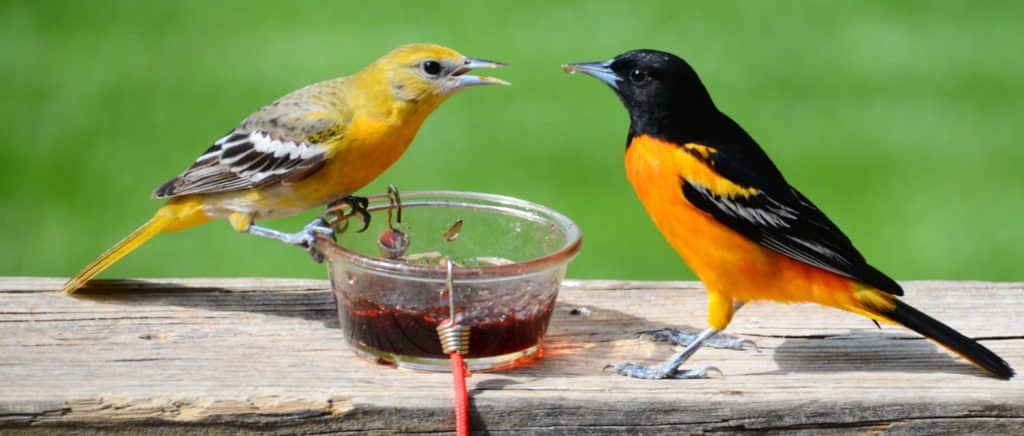14 Fun Facts About Orioles! (#7 is my favorite)
There are lots of interesting things to know and learn about orioles!

First, these birds are absolutely beautiful. Their fiery orange and yellow plumage makes them look like they belong in a tropical rainforest! And their beautiful songs are a cheerful addition to any backyard.
Additionally, even though orioles are not rare, they are uncommon to see. I know many people who have NEVER observed an oriole as these shy birds tend to stay high up in the trees. I love showing someone orioles at my feeders for the first time and witnessing how they can’t believe these birds exist near us!
Keep reading to learn 14 of my favorite facts about orioles.
#1. Orioles love the color orange.

Orioles are attracted to the color orange because it mimics many of the native flowers they drink from. Unfortunately, many backyard birders make the mistake of putting orange coloring in their oriole nectar, but this isn’t necessary. Instead, you can use an oriole feeder with an orange cap or base.
In addition, orioles also love to eat fruit, and oranges are one of their favorites! Try placing halved or quartered oranges in your backyard for them to consume. My favorite oriole feeder is the Ultimate Oriole Buffet. It has nails for hanging orange halves and cups for grape jelly, another favorite of orioles!
#2. Orioles can’t resist caterpillars.

Although many people associate orioles with nectar and jelly, they mostly eat these foods to replenish their strength after migrating. However, once orioles have started to nest, they switch to eating insects and spiders almost exclusively. Their favorite insect types are caterpillars like gypsy moth caterpillars, cabbage worms, and tent caterpillars. They even eat spiny and hairy caterpillars, which most other birds avoid!
Orioles also eat spiders, wasps, crickets, and grasshoppers, so if any of these critters are causing problems in your yard, try attracting orioles! Just make sure not to use pesticides because you’ll be killing their primary food source.
#3. Orioles have a sweet tooth. 🙂
Orioles enjoy eating sugar. And I mean, can we blame them?
Specifically, these birds enjoy sugary foods during and directly after their long migration north and south. The sweet, high-energy treats provide them with much-needed energy. Naturally, orioles drink nectar from flowers and look for fruit.
But luckily, bird feeding enthusiasts can attract orioles to their feeders in spring using the following sugary foods:
Jelly

When it comes to feeding orioles jelly, the grape flavor works best.
Jelly that is made for humans is fine for feeding orioles. Just head to your local grocery store and buy an inexpensive brand.
My preference is buying jelly that comes in a squeeze bottle to avoid the mess of scooping it out with a spoon! And make sure you purchase jelly and not jam.
Nectar
Like hummingbirds, orioles enjoy drinking sugar water for an instant energy burst!

You can purchase pre-made nectar, but it’s easy to make your own! Just mix 4 parts water with 1 part table sugar, and you’re done!
Unfortunately, you typically can’t use your existing hummingbird nectar feeders for orioles. That’s because their beaks are too big to fit into the tiny ports that typical hummingbird feeders possess.
#4. Orioles don’t eat birdseed.

Unfortunately, your regular bird feeders won’t attract orioles at all. This is because they don’t eat any typical feeder foods, like sunflower seeds and peanuts.
In addition to grape jelly, oranges, and nectar, one food that MAY attract orioles to your feeding station is dried mealworms. Since they’re insect larva, mealworms fit into the natural diet of orioles.
- RELATED: 5 SIMPLE Strategies That Attract Orioles! (Updated Guide)
#5. They’re extremely sensitive to pesticide use.
Pesticides are just about the worst thing you can use if you want to attract orioles!
Here’s why:
A. Orioles eat pests! Their diet is made up almost entirely of caterpillars, spiders, and insects that pesticides are designed to kill. If all these creatures die, the orioles will have nothing to eat. Since they don’t eat birdseed or other common bird foods, they’ll have to move on to find a meal.
B. Pesticides can contaminate other sources of food. For example, when Orioles arrive at their breeding grounds after migration, they eat fruit and nectar for quick energy. Pesticides can easily blow onto fruit trees and berry bushes, contaminating this food source and making the orioles sick.
Additionally, orioles may be better at controlling pests than the chemicals anyway! One of the best facts about orioles is that they eat many insects that cause damage to gardens but leave beneficial insects and pollinators alone. So, skip the pesticides and invite an oriole to dine in your backyard instead!
#6. Every oriole has a unique song.
All orioles sing clear, flutelike songs and whistle loudly. But each individual has a unique song that other orioles can identify!
They use songs and calls for many different purposes. For example, male mating orioles usually sing long, melodic songs, while warning calls are short, sharp “chucks.”

If an oriole is defending its territory or competing with another bird, it’s likely to make a series of staccato chirps that sound like “ah-ah-ah.”
#7. Oriole nests are incredible structures!

Orioles are the master engineers of the bird world!
This is my favorite fact about orioles. I find their nests to be truly amazing! They create intricately woven baskets that hang from tree branches. The materials can vary, but generally, orioles prefer long fibers pulled from immature trees or other hardy plants.
The baskets have three distinct layers. The outer layer is made of tough, durable fibers woven together like a basket. A second layer is made of springier materials like grass or bits of leaves. Finally, the interior is lined with downy material like cottonwood or cattail fluff, feathers, or delicate plants.
This complex nest is so durable that up to 85% of oriole nests are still hanging the next spring! Despite their durability, orioles rarely reuse a nest. However, they will take materials from existing nests to build new ones.
#8. Not all orioles are bright orange.

When most people think about orioles, they picture the bright orange and black of a Baltimore or Bullock’s Oriole. But the truth is, many orioles are yellow, burnt orange, or even brown!
Female and juvenile orioles have muted colors that range from grayish-brown to yellow. Even though they aren’t as bright, they’re still beautiful!
Orchard Orioles are another species that isn’t typically orange. They have a black hood and back similar to a Baltimore Oriole but a burnt orange or chestnut color on the chest. Some species like the Hooded Oriole and Scott’s Oriole are bright yellow.
#9. Orioles are members of the blackbird family.

This is a fact about orioles that many people find hard to believe.
Despite their bright coloring, orioles are members of the family Icteridae, which are blackbirds. Other members include grackles, red-winged blackbirds, and Brewer’s blackbirds.
Orioles were given their genus name from the Latin word aureolus, which means “golden.“ Their colorful feathers are all the more beautiful when you consider they’re actually blackbirds!
#10. There are eight oriole species in the United States!
It might surprise you to learn how many different types live in the USA because many of their ranges don’t overlap.

For instance, we only have two types here in Ohio, Baltimore and Orchard Orioles. But in California, there are three completely different species.
- RELATED: 8 Orioles That Live in the United States and Canada! (w/ Range Maps)
There are 33 species of orioles, but most of them stay in South America and Mexico year-round.
#11. There is a pro baseball team named after an oriole!
It’s true! The Baltimore Orioles are named after the popular bird that migrates to Maryland during the summer. It might seem like a simple connection, but actually, the history is complicated and fascinating!
The original leader of Maryland and the namesake of Baltimore was Lord Cecil Calvert Baltimore, and the colors of his family crest are orange and black. So, residents of Maryland began calling the Baltimore Oriole the “Baltimore-Bird” after Lord Cecil’s colors. The Baltimore Oriole has had a rich history in Maryland since well before the Major League Baseball team was started!

Once Major League Baseball started a franchise in Baltimore, it seemed only fitting that they would be named after the state bird, so the Baltimore Orioles were founded.
But, for a while, the baseball Orioles were the only Baltimore Orioles that existed! Believe it or not, from 1973 to 1994, Baltimore Orioles (the birds) were lumped in with a western relative, the Bullock’s Oriole, and called the Northern Oriole.
In 1995, the two species were split, and since then, two types of Baltimore Orioles come back to Maryland each spring. 🙂
#12. Orioles begin migrating south before most birds.
One of the least-known facts about orioles is WHEN you can spot them.
Although winter migration peaks during August or September, many orioles begin their journey south much earlier than that. Some individuals leave their nesting sites as early as the beginning of July!
In general, orioles leave their summer breeding grounds when their fledglings leave the nest. By October, nearly all orioles have reached their winter homes in Mexico, Central or South America.
In the spring, your best chance to see orioles is in late April to early May, when they’re still eating nectar and jelly to recover from their migration.
#13. They migrate during the night!
Like many other species, orioles migrate at night to avoid predators and inclement weather. Unfortunately, this can cause additional obstacles to their safe migration.

Orioles frequently collide with buildings during nighttime migration. This is because they use the moon and stars to navigate during night travel, and it’s thought that lighted windows in high-rise buildings confuse the birds. So instead of flying to their destination, they collide with the lighted windows.
One of the easiest ways to prevent collisions is to turn out the lights in your office or apartment! There are even programs in some major cities to remind residents of peak migration times!
#14. Orioles benefit from Bird Friendly certified coffee!

Orioles, like many migratory birds, depend on tropical forests in Central America for survival during the winter months. Unfortunately, these critical habitats are increasingly threatened by deforestation, often driven by agricultural practices such as sun-grown coffee farming, which replaces forests with open plantations.
Shade-grown coffee, on the other hand, is cultivated beneath a canopy of native trees, preserving the layered structure of the forest and maintaining vital ecosystems. This traditional method of farming allows orioles and other wildlife to find food, shelter, and safe resting places.

The Smithsonian’s “Bird Friendly” certification ensures that coffee is grown in a way that supports biodiversity by protecting habitats for a wide variety of bird species.
Choosing Bird Friendly coffee not only helps conserve forests but also provides a sustainable livelihood for coffee farmers.
Interested in purchasing some? Try Beautiful Beast Coffee Company! Specifically, their Bird Friendly bundle features ONLY coffee that meets the strict guidelines set forth by the Smithsonian.

What is your favorite fun fact about orioles?
Let us know in the comments!



